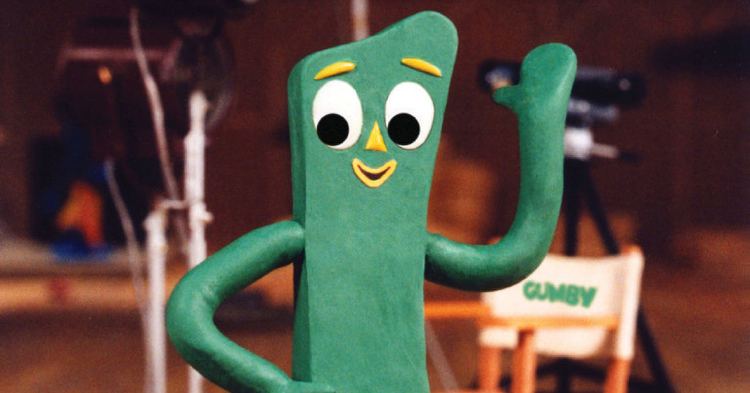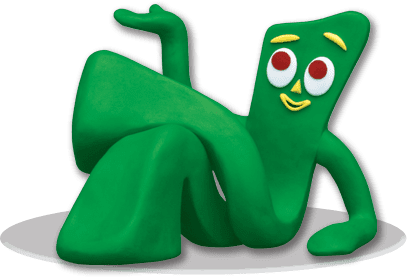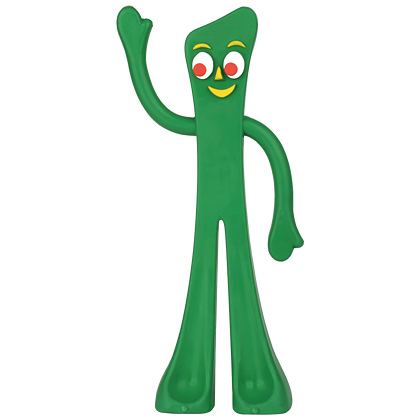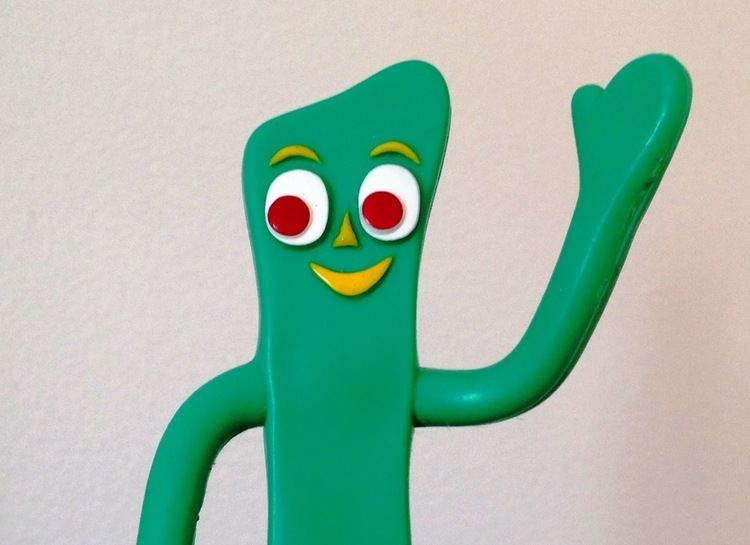Played by Dal McKennon | ||
 | ||
Films Gumby: The Movie (1995) Similar Mr Bill, Strawberry Shortcake, Noddy, Gumbys, Felix the Cat | ||
Gumby is an American clay animation franchise, centered on a green clay humanoid character created and modeled by Art Clokey. The character has been the subject of two television series as well as a feature-length film and other media. Since the original series' run, he has become well known as an example of stop motion clay animation and an influential cultural icon, spawning many tributes, parodies, and merchandising.
Contents
- Overview
- 19531968 Origins
- 1988 Revival
- 1990present Feature film and reruns
- Cast
- Reception and legacy
- Merchandising
- References

Overview

Gumby follows the titular character and his adventures through different environments and times in history. Gumby's principal sidekick is Pokey, a talking orange pony. His nemeses are the Blockheads, a pair of humanoid, red-colored figures with cube-shaped heads, who wreak mischief and havoc. The Blockheads were inspired by The Katzenjammer Kids, who were always getting into scrapes and causing discomfort to others. Other characters are Prickle, a yellow dinosaur who sometimes styles himself as a detective with pipe and deerstalker hat like Sherlock Holmes, and Goo, a flying blue mermaid who spits blue goo balls and can change shape at will. Also featured are Gumby's dog Nopey, whose entire vocabulary is the word "nope," and Gumby's parents, Gumbo and Gumba. The later syndicated series in 1988 added Gumby's sister Minga and mastodon friend Denali.
1953–1968: Origins

Gumby was created by Art Clokey in the early 1950s after he finished film school at the University of Southern California. Clokey's first animated film was a 1953 three-minute student film called Gumbasia, a surreal montage of moving and expanding lumps of clay set to music in a parody of Disney's Fantasia. Gumbasia was created in a style that Clokey's professor Slavko Vorkapić taught at USC called Kinesthetic Film Principles, described as "massaging of the eye cells." This technique of camera movements and editing was responsible for much of the Gumby look and feel. In 1955, Clokey showed Gumbasia to movie producer Sam Engel, who encouraged him to develop his technique by animating figures into children's stories.

Clokey moved forward, producing a pilot featuring the character Gumby, which derived its name from the muddy clay found at Clokey's grandparents' farm that his family referred to as "gumbo". The look of Gumby was inspired by a suggestion from his wife Ruth (née Parkander) that Clokey base his character on The Gingerbread Man. The color green was then chosen because Clokey saw it as a racially neutral color, as well as being a symbol of life. Gumby's legs and feet were made wide for pragmatic reasons: they ensured that the clay character would stand up during stop-motion filming. The famous slanted shape of Gumby's head was based on the hair style of Clokey's father Charles Farrington in an old photograph.
NBC executive Thomas Warren Sarnoff saw and loved Clokey's first pilot and had Clokey make another one ("Gumby on the Moon"). This became a huge hit on Howdy Doody, leading Sarnoff to order Gumby his own series in 1955 entitled The Gumby Show. In 1955 and 1956, 22 eleven-minute episodes aired on NBC. Gumby's voice was originally provided by Ruth Eggleston, wife of the show's art director Al Eggleston, until Dallas McKennon became the primary voice of Gumby in 1957. Because of its variety-type format, the show featured Clokey's puppet films plus interviews and games, as well. During this time, the show went through a succession of two hosts: Robert Nicholson and Pinky Lee.
In 1959, the show entered syndication and more episodes were later produced in the 1960s. Production started in Hollywood but soon after in 1960 moved to a larger studio in Glendora, California where it remained through the 60's. Production continued through 1968, by which time Norma MacMillan voiced Gumby. On some occasions during this time, Gumby's voice was provided by Ginny Tyler and Dick Beals.
1988: Revival
Beginning in 1982, Eddie Murphy began a parody of Gumby on Saturday Night Live. According to Murphy’s parody, when the television cameras were turned off, the sweet Gumby reverted to his true self: a cigar chomping, irascible celebrity who was highly demanding of the production executives. Whenever the executives refused to give in to his demands, Gumby would assert his star status by saying “I’m Gumby, dammit!”
In 1987, the original Gumby shorts enjoyed a revival on home video. The following year, the character appeared in The Puppetoon Movie.
This renewed interest led to a new incarnation of the series consisting of ninety-nine brand new 7-minute episodes produced for television syndication in association with Lorimar-Telepictures in 1987. Dallas McKennon returned as the voice of Gumby in the new adventures that would take Gumby and his pals beyond their toyland-type setting and establish themselves as a sing-a-long band. The show also included new characters, such as Gumby's little sister Minga and a mastodon named Denali.
In addition to the new episodes, the classic 1950s and 1960s shorts were re-run as part of the series, but with newly recorded soundtracks, with the voices re-recorded and the original music replaced by Jerry Gerber's synthesizer score from the 1988 series. Clokey's rights to use the original Capitol Records production tracks could not be renewed at the time, due to legal issues.
1990–present: Feature film and reruns
In 1995, Clokey's production company produced an independently released theatrical film, Gumby: The Movie (a.k.a. Gumby 1), marking the clay character's first feature-length adventure. In it, the villainous Blockheads replace Gumby and his band with robots and kidnap their dog, Lowbelly. The movie featured in-joke homages to such sci-fi classics as Star Wars, The Terminator, and 2001: A Space Odyssey. Starting in 1992, TV channels like Nickelodeon and Cartoon Network aired re-runs of Gumby episodes. In 1998, the Gumby episode "Robot Rumpus" was featured on Mystery Science Theatre 3000.
On March 16, 2007, YouTube announced that all Gumby episodes would appear in their full-length form on its site, digitally remastered and with their original soundtracks. This deal also extended to other video sites, including AOL. In March 2007, KQED-TV broadcast an hour-long documentary Gumby Dharma as part of their Truly CA series.
In 2012, Me-TV began airing Gumby as a part of a weekend morning animation block. The show remained part of the channel's programming until the end of the year.
On April 8, 2015, it was announced that there is a new Gumby series in the works which will be co-produced by the Jim Henson Company, but as of August 2016 there has been no new information.
Cast
Reception and legacy
In 1993, TV Guide named Gumby the best cartoon series of the 1950s in its issue celebrating 40 years of television.
Beginning in 1994, the Library of Congress used Gumby as a spokescharacter due to a common sequence in the show where Gumby walks into a book and experiences the world within the book as a tangible place. This then led to a traveling exhibit called Adventures into Books: Gumby's World, a promotion for the Center for the Book's national reading campaign from 1997 to 2000. By the end of the 90s, Gumby and Pokey had also appeared in commercials for Cheerios cereal, most notably Frosted Cheerios.
On August 4, 2006, the Center for Puppetry Arts in Atlanta opened Art Clokey's Gumby: The First Fifty Years, an exhibition featuring many of the original Puppets and sets; along with screening the films of Art Clokey. The event, conceived by David Scheve of T.D.A. Animation and Joe Clokey of Premavision was one of several exhibits that opened around the country, celebrating the fiftieth anniversary of The Gumby Show. The children's book Gumby Goes to the Sun was also published that year to coincide with the anniversary. Written and illustrated by Clokey's daughter, Holly Harman, the book was originally created in the 1980s.
In 2007, the Gumby comic book series was nominated for two Eisner Awards, winning one of them, Best Publication For a Younger Audience.
On October 12, 2011, Google paid tribute to Art Clokey’s 90th birthday featuring clay balls transforming into characters from Gumby. The doodle was composed of five clay balls in the Google colors placed beside a toy block with a "G" on it. Clicking any of the balls revealed the Blockheads, Prickle, Goo, Gumby, and Pokey.
In a 2014 episode of the Disney XD series Gravity Falls called "Little Gift Shop of Horrors", the character of Soos Ramierez appears in the "Clay Day" segment of that episode as a character that looks very much like Gumby.
Merchandising
Various Gumby merchandise has been produced over the years, the most prominent item being bendable figures. Several single packs and multi-figure sets by Jesco (later Trendmasters), as well as a 50th anniversary collection, have been made of the Gumby characters. Also included in the Gumby merchandise catalog are plush dolls, keychains, mugs, a 1988 Colorforms set, a 1995 Trendmasters playset, and a Kubricks set by Medicom. A tribute album, Gumby: The Green Album, produced by Shepard Stern was released in 1989 through Buena Vista Records.
In August 2005, the first video game featuring Gumby, Gumby vs. the Astrobots, was released by Namco for the Game Boy Advance. In it, Gumby must rescue Pokey, Prickle, and Goo after they are captured by the Blockheads and their cohorts, the Astrobots.
The Gumby images and toys are registered trademarks of Prema Toy Company. Premavision owns the distribution rights to the Gumby cartoons, having been reverted from previous distributor Warner Bros. Television in 2003, and had licensed the rights to Classic Media until September 30, 2012. At this time, Classic Media was officially acquired by DreamWorks Animation and branded as DreamWorks Classics, which became a subsidiary of NBCUniversal in 2016.
As of April 2015, NCircle Entertainment owns home video and digital distribution rights to the cartoons.
